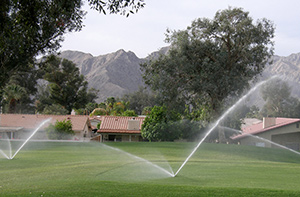Is El Niño a boom or a bust?
 California ranks No. 2 nationally in total number of U.S. golf courses, behind No. 1 Florida. After the recent multi-year drought, which sparked mandatory water restrictions to all sectors of water users from homeowners to the agriculture industry, the 2016 El Niño was heralded as the potential savior for all.
California ranks No. 2 nationally in total number of U.S. golf courses, behind No. 1 Florida. After the recent multi-year drought, which sparked mandatory water restrictions to all sectors of water users from homeowners to the agriculture industry, the 2016 El Niño was heralded as the potential savior for all.
California water authorities anxiously awaited the forecasted 2016 El Niño promise of increased rain to help the state recover from the drought conditions, which have prevailed the past five years. Unfortunately, California’s traditionally wet season of October to March has mostly been a bust, especially for Southern California.
Northern California has received a fair amount of rain and good snowfall amounts, causing some improvement to the state’s reserve water supplies. Meanwhile, the high- and low-pressure systems have combined to steer most rainstorms eastward before they get to Southern California.
I contacted several superintendents in Northern California and they reported decent rainfall amounts, however, most said the rainfall totals were below last year’s amounts for this same time period.
Troy Flanagan, superintendent of the Olympic Club, was my first NorCal contact. He said the El Niño effect on golf concerns was premature. “In 2014 during our traditionally wet season we received around 18 inches,” he said. “This year we are at 12.25 inches and counting.”
Seventy miles to the south, Justin Mandon, superintendent at Pasatiempo GC, reported rainfall amounts ranging from 30 to 40 inches for October 2015 through March 2016. When I asked him to explain the big difference between Pasatiempo and Olympic, Mandon said, “We have a mountain range close to the coast, and it causes the fronts to drop more of their rain on us.”
I’m learning the weather patterns of California since our move in October 2015. When we got the first of the January rains, it only took 24 to 48 hours for the sparse brown hillsides surrounding the San Fernando Valley to sprout grass and other plant life. Then Mother Nature pulled one of her “gotchas.” February turned warmer and less rain fell during the month. The green-up didn’t disappear, but the encouraging snowpack began to melt and give up its promise of providing longer-term drought relief.
For folks in Los Angeles and points south, it is maddening to watch the nightly newscast, showing the bands of rain work south time and time again only to peter out around Santa Barbara and then fade or move eastward. Since I’ve been here I can count on one hand the numbers of times rain events have exceeded half an inch in the Van Nuys/Sherman Oaks area.
Pressure to conserve water in California builds with every missed rainstorm. The golf industry here has responded with typically positive cooperative actions. While the misconception of golf as a big water user persists, actual statistics show nationally and state-by-state that golf water usage is much less compared with agriculture, public usage, business and industry.
California mandated a statewide 26-percent water use reduction for most of the classes of water users. These reductions include most of the municipalities and businesses, including golf. The majority of homeowners responded by reducing their consumption, with the exception of a few wealthy folks. Their rates have since been raised and increased penalties are being imposed, including shaming over-users in the press.
Meanwhile, California golf course superintendent chapters like the Hi-Lo Desert GCSA have been praised in the media for their cooperation and for detailing the conservation steps they take.
Water issues across the United States are becoming ever more critical for the agriculture and green industries. Reach out and start dialogues with your state and local regulatory agencies, and maybe also ask Mother Nature for a little help, too.
Photo credit: Nemo’s great uncle via Foter.com / CC BY-NC-SA










